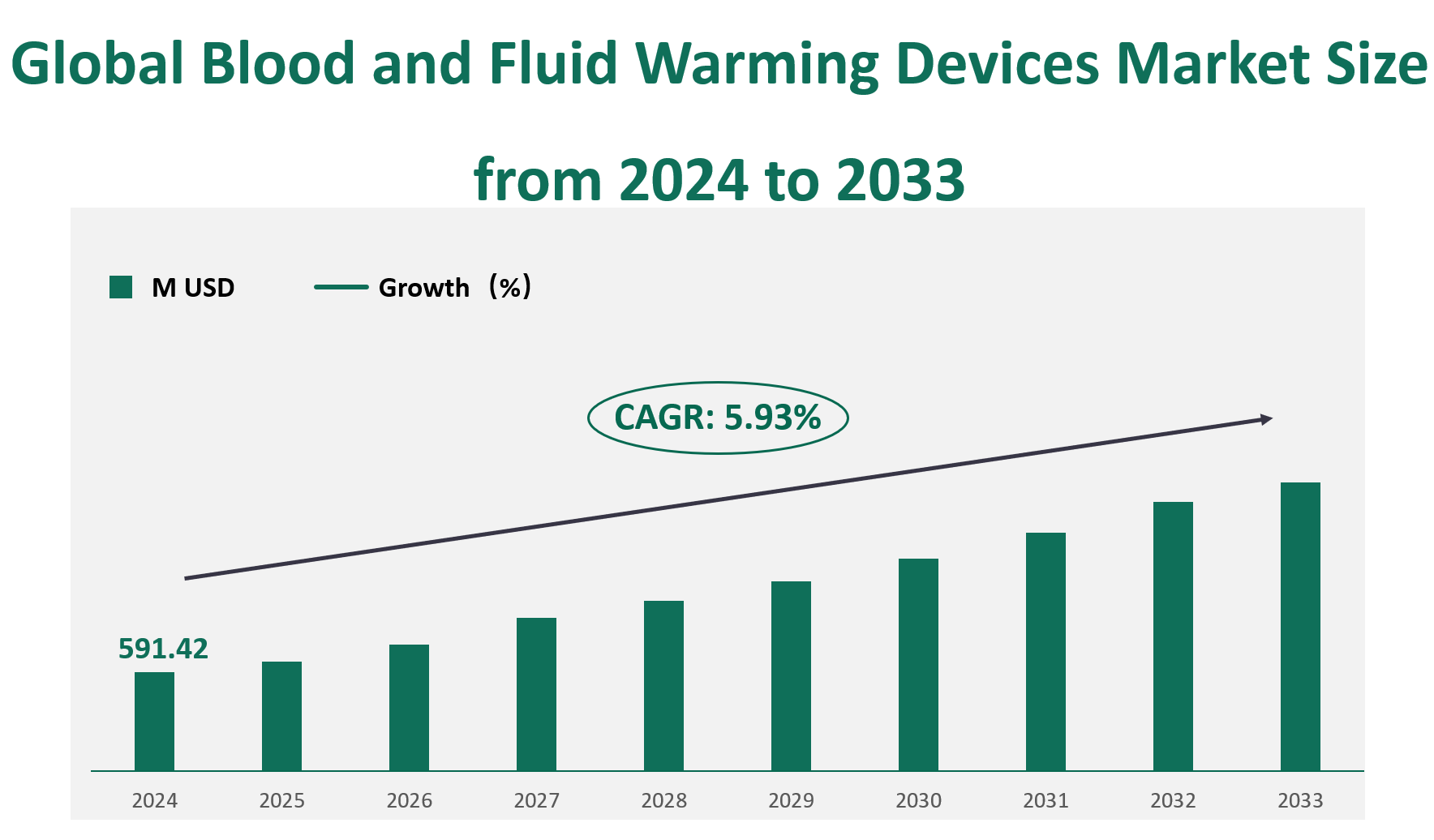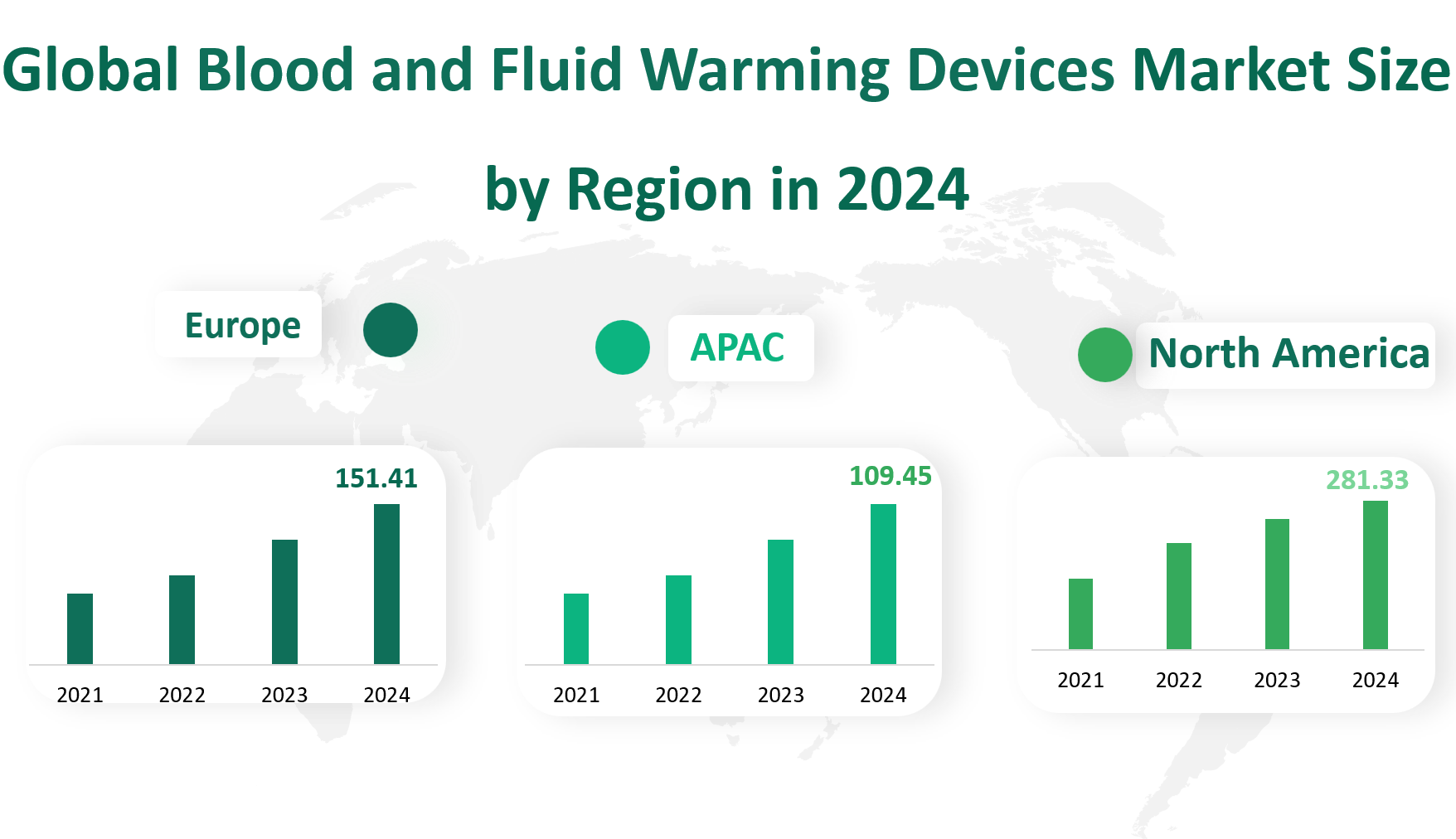1. Global Blood and Fluid Warming Devices Market Insight Analysis
The global Blood and Fluid Warming Devices market is projected to reach a value of $591.42 million USD in 2024, with a Compound Annual Growth Rate (CAGR) of 5.93% from 2024 to 2033.
Blood and Fluid Warming Devices are essential medical tools designed to maintain the body temperature of patients by warming blood and intravenous fluids before they are administered. These devices are crucial in preventing hypothermia, which can be a significant risk during surgical procedures, emergency treatments, and other medical interventions. The market for these devices includes both portable and stationary units, with portable devices accounting for a larger share due to their versatility and ease of use. The primary applications of these devices are in operating rooms, recovery rooms (PACU), intensive care units, emergency rooms, and military settings.
Figure Global Blood and Fluid Warming Devices Market Size (M USD) and CAGR (2024-2033)

2. Driving and Limiting Factors of Blood and Fluid Warming Devices Market Growth
The growth of the Blood and Fluid Warming Devices market is influenced by several driving factors. The primary drivers include the aging global population, which increases the prevalence of chronic diseases and the need for surgical interventions. Additionally, the continuous improvement of healthcare systems worldwide has led to better access to advanced medical equipment, including blood and fluid warming devices.
The increasing awareness of the importance of maintaining patient body temperature during medical procedures has also contributed to the market’s expansion. Furthermore, emerging economies are investing more in healthcare infrastructure, creating new opportunities for market growth.
However, there are also limiting factors that may hinder the market’s growth. One significant challenge is the high cost of these devices, which can be prohibitive in low-income regions. Additionally, the lack of proper training and awareness among medical personnel in some areas may limit the widespread adoption of these devices.
Safety concerns, such as the risk of hemolysis or contamination from warming equipment, also pose potential barriers to market expansion. Moreover, regulatory hurdles and stringent government policies can slow down the introduction and adoption of new technologies in the market.
3. Technology Innovation and Corporate Mergers and Acquisitions in Blood and Fluid Warming Devices Market
The Blood and Fluid Warming Devices market is characterized by continuous technological innovation. Companies are focusing on developing more efficient and safer devices to meet the growing demand from healthcare providers. Innovations include the use of advanced materials that ensure better heat distribution and prevent contamination, as well as the integration of smart technologies that allow for real-time monitoring and control of warming processes. For example, some modern devices come equipped with digital displays and automated temperature control systems, enhancing their usability and reliability.
Corporate mergers and acquisitions are also shaping the market landscape. Major players such as 3M, Smiths Medical, and Baxter International are actively involved in strategic partnerships and acquisitions to expand their product portfolios and strengthen their market positions. These activities not only enhance the companies’ capabilities but also drive competition, leading to further innovation and better products for consumers. Additionally, emerging players from regions like Asia-Pacific are gaining traction, contributing to the diversification of the market and introducing new technologies and business models.
4. Global Blood and Fluid Warming Devices Market Size by Type
The blood and fluid warming devices market is primarily categorized into two types: Portable and Stationary.
Portable devices are designed to be lightweight and compact, making them ideal for use in various settings, including emergency response, military operations, and ambulances. These devices are particularly useful for warming small quantities of blood and fluids quickly and efficiently. In 2024, the market value for portable devices is forecasted to be approximately $417.40 million USD.
Stationary devices, on the other hand, are larger and more robust, designed to handle multiple units of blood and fluids simultaneously. They are typically used in hospitals and medical centers where there is a need for continuous and large-scale warming of fluids. The market value for stationary devices in 2024 is forecasted to be around $174.02 million USD.
Table Global Blood and Fluid Warming Devices Market Size by Type in 2024
5. Global Blood and Fluid Warming Devices Market Size by Application
The operating room is a critical environment where precise temperature control of blood and fluids is essential to prevent hypothermia in patients undergoing surgery. Blood and fluid warming devices used in ORs are designed to maintain optimal temperatures during surgical procedures. The revenue generated from this application in 2024 is forecasted to be around $219.80 million USD.
The Post-Anesthesia Care Unit (PACU) is where patients recover from anesthesia after surgery. Warming devices in PACUs help stabilize patients’ body temperatures, reducing the risk of complications. The revenue for this application in 2024 is projected to be approximately $99.15 million USD.
Intensive care units cater to critically ill patients who require continuous monitoring and treatment. Blood and fluid warming devices in ICUs ensure that patients receive warmed fluids to maintain their body temperature and prevent hypothermia. The revenue for this application in 2024 is expected to be around $147.83 million USD.
Emergency departments handle urgent medical cases where rapid warming of blood and fluids is crucial. These devices help maintain patient temperature during critical care. The revenue for this application in 2024 is forecasted to be approximately $44.58 million USD.
In military settings, blood and fluid warming devices are essential for field operations, ensuring that wounded soldiers receive warmed blood and fluids to prevent hypothermia and shock. The revenue for military applications in 2024 is projected to be around $36.02 million USD.
Table Global Blood and Fluid Warming Devices Market Size by Application in 2024
Application | Market Size (M USD) 2024 |
Operating Room | 219.80 |
Recovery Room (PACU) | 99.15 |
Intensive Care | 147.83 |
Emergency Room | 44.58 |
Military Applications | 36.02 |
Others | 44.05 |
6. Global Blood and Fluid Warming Devices Market by Top Regions
North America remains the largest market for blood and fluid warming devices, driven by advanced healthcare infrastructure, high demand for medical devices, and significant investments in research and development. In 2024, the market value in North America is forecasted to be $281.33 million USD, accounting for approximately 47.57% of the global market share.
Europe follows closely behind North America, with a market value of $151.41 million USD in 2024, representing 25.60% of the global market share. European countries, particularly Germany, the UK, and France, are key drivers of this market.
The Asia-Pacific region is emerging as a significant player in the blood and fluid warming devices market. With a forecasted market value of $109.45 million USD in 2024, it holds 18.51% of the global market share. Rapid economic growth, increasing healthcare spending, and a growing aging population are key factors driving the market in this region.
South America is projected to have a market value of $25.65 million USD in 2024, accounting for 4.33% of the global market share. Brazil is the leading country in this region, contributing significantly to the overall market value.
The Middle East and Africa region is expected to have a market value of $23.58 million USD in 2024, representing 4.02% of the global market share. Countries like Saudi Arabia and the UAE are key contributors to this market.
Figure Global Blood and Fluid Warming Devices Market Size by Region in 2024

7. Global Blood and Fluid Warming Devices Market Analysis by Major Players
7.1 3M
Company Introduction and Business Overview
3M is a global leader in diverse technologies and products, with a strong presence in the healthcare sector. Established in 1902, 3M operates in electronics, telecommunications, industrial, consumer, and office markets, among others. The company is renowned for its innovative products and strong brand presence worldwide.
Products Offered
3M offers a range of blood and fluid warming devices, including the 3M™ Ranger™ Blood/Fluid Warming Unit. This portable device is designed to safely and effectively warm fluids from KVO to 30,000 mL/hr, making it suitable for various medical settings.
7.2 Smiths Medical
Company Introduction and Business Overview
Smiths Medical, established in 1940, is a leading designer, manufacturer, and distributor of medical devices. The company offers a wide range of infusion therapy products, including ambulatory infusion pumps, implantable access systems, and dialysis equipment.
Products Offered
Smiths Medical’s HOTLINE® Blood and Fluid Warmer is a notable product in the blood and fluid warming devices market. This device delivers normothermic fluid at routine flow rates, ensuring patient safety and reducing the risk of hypothermia.
7.3 Baxter International
Company Introduction and Business Overview
Baxter International, established in 1931, is a global leader in developing, manufacturing, and marketing products and technologies related to hemophilia, immune disorders, infectious diseases, kidney disease, trauma, and other chronic and acute medical conditions.
Products Offered
Baxter International’s TherMax blood warmer, powered by the PrisMax system, is a key product in the blood and fluid warming devices market. This device offers efficient blood warming to maintain patient blood temperature during CRRT therapy.

